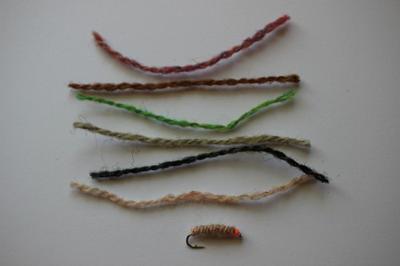Does Yarn Color Make a Difference?
by John Evans
(San Antonio, TX)

And The Winner Is . . .
Does Yarn Color Make a Difference?
One question tenkara anglers like to debate is whether the color of flies, nymphs, or streamers makes much of a difference in catching fish. I know some well-respected fishermen who say that color doesn’t matter. Just reach into the fly box and grab whatever strikes your fancy; the fish don’t care. Other anglers insist that color makes all the difference in the world.
What’s the truth? I thought I’d tell readers about a little experiment I ran last month at my local fishing hole to see if I could get an answer. No, this was not a scientific study, and I’m sure there are plenty of flaws in my approach, but the results may help.
I tied up some simple crane fly larva/killer bug pattern nymphs on size 11 Alec Jackson Covert Daiichi hooks (yes, those expensive ones) in six different colors of yarn and fished on five separate days in the exact same spot. I used the same number of lead-free wraps of wire on the hooks and tried to fish in more-or-less the same way. I also varied the order of the six colors I used on the different days in case the fish were simply going after the first bug they saw and then laying off the others after they got stirred up. I used a dead drift followed by a slow, twitchy rise and fished about the same length of time with each color. The spot I fished is loaded with panfish and small bass, and almost always produces a fair number of catches.
What did I learn? At least in my limited testing, yarn color definitely does make a difference. First, let me say that I caught fish on every color of yarn. No color was a complete bust, and all colors were useful. Also, in the spot I fish, there are some Rio Grande Perch/Texas Cichlids, and they seem to prefer black, or at least dark-colored yarn, as I reported in another blog entry. But, the clear winner on all five days was the Jamieson Shetland Spindrift Oyster yarn tied with fluorescent pink thread. (Imagine that: The yarn that is most often recommended for the Killer Bug is the yarn that worked best!) Some colors of yarn were ignored until I did quite a bit of twitching on the lift. In fact, by rough count the oyster yarn was better by an almost 2-to-1 margin. This was true whether I used the oyster color first, last, or in the middle of my experiment.
So, in warm, lightly-stained waters, in South Central Texas, there was one yarn color that out-fished five other colors on five separate days. On no day did it come in second or third best.
Why did the oyster color work best? Only a fish could say. Several writers have commented on how the oyster yarn changes color in an unusual way once it is wet. It turns a pinky-tan-translucent color that, to my eye, seems lifelike. Most yarns just get darker. But, how do fish see it, and why did my fish find it appealing in the summer? As anglers, we’re interested in the results but can only theorize about the “why”.
I want to caution against drawing too many conclusions from this very limited experiment. In fact, my trial raises more questions than it answers. Also, remember that all the yarns caught some fish. Would fish in other parts of the country, in other types of water, react the same? What is the role of the underlying thread color? Would the size and color of the hook influence which color of yarn works best? Would seasons of the year make a difference, and how about different species of fish? Is it possible that I just fished the oyster yarn more confidently? (After all, I didn’t fish blindfolded!) The number of variables ensures that the debate will continue.
Next time around, I plan to improve my efforts in several ways. For example, I need to include more repetitions and more yarn colors, plus keep an exact chart of the results. Five days and six colors of yarn is just too small of a sample size. It seems, however, that color makes some difference in some way, and it’s not accurate to say, “One color of artificial fly is just as good as another.” See the accompanying photo for the yarns I used, plus the “winning” pattern.
Perhaps my brief experiment will encourage others to try something similar on their local waters and, in this way, we can learn together.
Return to Your Tenkara Stories.
“The bitterness of poor quality remains long after the sweetness of low price is forgotten” - Benjamin Franklin
"Be sure in casting, that your fly fall first into the water, for if the line fall first, it scares or frightens the fish..." -
Col. Robert Venables 1662
As age slows my pace, I will become more like the heron.
Warning:
The hooks are sharp.
The coffee's hot.
The fish are slippery when wet.
Beware of the Dogma
Currently processing orders that were received Mar 8.


